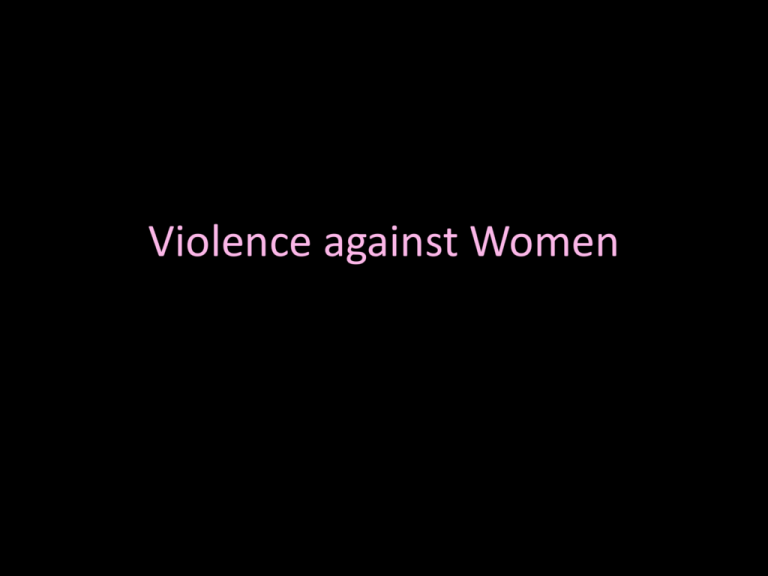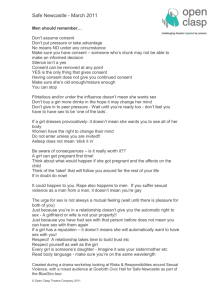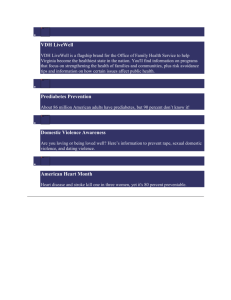
Violence against Women
Global Problem
• Widespread and serious (obviously) and must be
addressed in any consideration of the psychology of
women
• What impact does it have on a woman’s psychology
for her to know that she may be vulnerable to
violence in so many situations? How are her feelings
affected by media treatments of violence? By the
cultural norms and laws that relate to such violence?
How does the fear of violence, or actually being a
target of violence, affect her behaviour?
New Dehli, India
• A 15-year old girl married a man selected for her by
her conservative Muslim parents. According to
tradition, she came to the marriage with dowry of a
refrigerator, furniture, and other household goods.
The family could not afford one of the items
demanded by the groom (a motorcycle). On their
wedding night, the annoyed groom got drunk, and
with three of his friends, took turns beating and
raping his new wife. The girl returned to her parents
who sought justice from the village council. Their
ruling was that she should return to her husband and
“let bygones be bygones”.
Seoul, South Korea
• A man who had been married for 20 years
commented to a reporter that he, of course, beat his
wife regularly throughout their marriage. “For me,
it’s better to release that anger and get it over with …
otherwise, I just get sick inside … Of course, you have
to apologize later, otherwise you can have bad
feelings in your relationship with your wife” .
• One survey revealed that 42% of South Korean wives
said that they had been beaten by their husbands.
Minnesota, United States
• Women working in an iron-ore mine filed suit against
their employer and their union for failing to stop the
sexual harassment that made their workplace a living
hell. The women testified that they had been
“groped, grabbed, pressured for sex, threatened with
rape, beaten, stalked, and subjected to coarse
language and graffiti”. Among the incidents the
women recounted: men grabbing their crotches,
stalking them during off-hours, masturbating into
their lockers, addressing them as slang terms for
female parts (instead of their names), and
threatening them with rape and other physical
violence.
Gujar Khan, Pakistan
• A husband came home one day and accused his wife
of having an affair with her brother-in-law. She
denied the accusation but the husband tied her up
and slashed her face with a razor and a knife, cutting
out her eyes and slicing off her earlobes and nose.
• While awaiting trial, the man stated: “I did these
things, but I was going out of my senses. She was
provoking me and ruining my life. What I did was
wrong, but I am satisfied. I did it for my honour and
my prestige”. Later, other local men who saw pictures
of the woman’s mutilated face commented: “She
must have deserved it” and that her husband “did
what a man has to do”.
The Role of Culture
• Individuals are important but we also need to look
beyond the psychology of individual women and men
and try to understand how cultures (including “minicultures” such as workplaces, families) cooperate
and reproduce the violence, even while sometimes
deploring it
• What cultural forces support violence against
women? What strategies work to minimize this
violence in society?
Close Relationships
1. Dating violence
2. Husbands and wives
•
•
Psychological and emotional abuse
Wife murder for money or “honour”
3. Violence in lesbian couples
4. Explaining partner abuse
Violence in Close Relationships
• In North America, approximately 30% of
female homicide victims are killed by an
intimate partner
• In countries such as Bangladesh, Brazil, Kenya,
and Thailand, this figure is over 50%
1. Dating Violence
• In North America, dating violence is estimated
to occur in 20% of dating relationships
• Approximately 1/3 of the women involved in
violent dating relationships expect to marry
their abusers
Dating violence continued …
• Why do women stay?
• Causal attributions that women make for
men’s violent behaviour
– Violence occurs when the relationship is
threatened through jealousy, dating others,
suspicion of infidelity, or discussion about ending
the relationship
– Therefore, women might interpret the violence as
being a sign of the men’s commitment or love
Well I'd rather see you dead, little girl
Than to be with another man
You better keep your head, little girl
Or I won't know where I am
Let this be a sermon
I mean everything I've said
Baby, I'm determined
And I'd rather see you dead
You better run for your life if you
can, little girl
Hide your head in the sand little girl
Catch you with another man
That's the end'a little girl
You better run for your life if you can,
little girl
Hide your head in the sand little girl
Catch you with another man
That's the end'a little girl
Well you know that I'm a wicked guy
And I was born with a jealous mind
And I can't spend my whole life
Trying just to make you toe the line
I'd rather see you dead, little girl
Than to be with another man
You better keep your head, little girl
Or you won't know where I am
You better run for your life if you can,
little girl
Hide your head in the sand little girl
Catch you with another man
That's the end'a little girl
You better run for your life if you can,
little girl
Hide your head in the sand little girl
Catch you with another man
That's the end'a little girl
(Run for your Life, The Beatles, 1965)
Dating violence continued …
• Adolescent girls who report dating violence are more
likely than other girls to report a number of other
problems:
–
–
–
–
Higher risk of substance abuse
Unhealthy weight control behaviours
More likely to have had 1st sexual experience before age 15
More likely to engage in risky sexual behaviours (e.g.,
many partners, no birth control)
– More likely to become pregnant in adolescence
– More likely to attempt suicide
Dating violence continued …
• Although violent relationships are dangerous,
terminating the relationship is also dangerous
• Many women are stalked and threatened
• Bangladesh (1990s) “acid attacks”
– Rejected suitors spray nitric acid in women’s faces,
causing excruciating pain and severe
disfigurement
Exaggerated sense of entitlement
• Violent men often think that women owe
them the acceptance of their advance,
intimacy, and submission to their will
• On what is this sense of entitlement based?
– History of wife abuse provides some insight
2. Husbands and Wives
• In many cultures, men have traditionally
claimed to beat their wives as a matter of
authority, superiority, and control over
property.
• Old Korean saying: “Dried fish and women:
both are better after they are beaten”
Husbands & Wives continued …
• Violence in marriage is linked historically to a legal
definition of the family in which the wife is the
property of the husband and the husband is the clear
authority over her.
• Such legal tradition prevailed an ancient Greece and
Rome, in Europe in the Middle Ages, and in Britain
and North America until at least the last century. This
tradition is still in effect in countries such as Saudi
Arabia and Pakistan.
Husbands & Wives continued …
• It has been, as in some place still is, acceptable for a
man to “correct” his wife through physical
aggression—as long as she is not hurt “too seriously”
– e.g., in Nigeria, a husband may not be charged with abuse
if he does not leave a scar on his wife or if she does not
require more than 21 days in the hospital
– In Mexico, if a woman heals within 15 days, the husband is
often pardoned or lightly sentenced
– Even in places where the laws have changed over time,
custom often continues to support these violent
behaviours
Husbands & Wives continued …
• If and when a woman leaves a violent
situation, she risks further violence (risk of
murder is highest when the victim tries to
escape from an abusive relationship)
• This desperation can lead to women
committing murder in order to save
themselves and their children
Examples in Music
• Goodbye, Earl – The Dixie Chicks
• Independence Day – Martina McBride
Husbands & Wives continued …
• The abuse is not always confined to the home
• Many women receive threatening phone calls,
are stalked and harassed
– Researchers estimate that ¼ to ½ of employed
battered women have lost a job because of the
violence/harassment
– Most workplaces do not have any policies in place
for victims
Psychological & Emotional Abuse
•
•
•
•
Threats
Insults
Isolation
Most women who are being hurt physically
also suffer psychological and emotional abuse
• Women who have been abused are 12 times
more likely (than other women) to commit
suicide
Wife Murder: Money
• Marriage is often an economic arrangement (e.g.,
India)
• Men are often bribed (e.g., with dowries) to marry;
parents often go in debt to marry off their daughters
• New brides are often pressured to get more
money/goods from their parents; in-laws have
doused new brides in kerosene and lit them on fire
when they failed to acquire more goods (the deaths
are reported as “kitchen accidents”)
– It is estimated that approximately 5000 women/year fall
victim to dowry-related murders in India
Wife Murder: Honour
• Dishonouring one’s husband or father is often seen
as a “legitimate” reason for murder
• Often related to the woman being unfaithful
• It is believed that these “honour killings” erase the
shame brought to male members of a family
(husband, father, brother)
– Jordan, Saudi Arabia, Egypt, Bangladesh, Pakistan, Sudan
Wife Murder: Honour
• Sometimes premeditated (not just done in a rage);
e.g., men of the family may gather to vote on the
death of the woman and decide who will carry out
the killing
• common themes:
– Women are considered property
– Men are believed to be entitled to wield authority and
punish women
– The family is viewed as a private institution where the man
rules and outsiders should not interfere
– Women are inferior to men
Implications
• Patriarchal attitudes spill over to affect not
only violence against women in families, but
also sanctioned societal violence against
women who violate standards of approved
behaviour
– e.g., prostitutes are at risk for violence because
they are seen as “bad”, immoral, worthless, less
than human
– Engaging in premarital sex or adultery can result in
death
3. Violence in Lesbian Couples
• Patriarchal attitudes are not the only underlying
factor in violent relationships
• Researchers suggest that the prevalence of violence
in lesbian and heterosexual couples is similar;
reasons are also similar: issues of commitment to the
relationship, jealously, autonomy or dependency,
drug/alcohol abuse
• It is obvious, therefore, that much more research is
needed to understand violence in relationships (since
traditional ‘explanations’ tend to rely on blaming
patriarchal attitudes)
4. Explaining Partner Abuse
1.
Socio-political or cultural analysis: focuses on the ways that
cultural beliefs, social structures, and political factors
contribute to and support the occurrences of violence
•
The atmosphere of patriarchal societies (i.e., where male
domination/female subordination is approved of and
rewarded) promotes violence against women
The rigidity of gender roles and expectations: the narrower
the role, the more likely it is that women will stray from it
Stressors: e.g., poverty, social isolation, discrimination
•
•
Explaining Partner Abuse continued …
2.
Interpersonal dynamics
•
Social learning theory: individuals learn behavioural strategies that they
feel are effective by watching other people; if an abuser successfully
exerts control over the victim and/or gets what he/she wants, then
violence as a strategy is reinforced and will likely increase in frequency
•
Violence does not always work as a control mechanism in relationships
because the target may fight back, leave, press charges, etc.; an abuser
usually believes that the partner will put up with the violence, that it
will work as a form of control, and that the abuser will suffer no
disastrous consequences
•
Social power perspective: the abuser must have a sense of possessing
greater social power in the relationship than the partner does; e.g., the
victim is emotionally or financially dependent and cannot leave; the
victim is socially isolated and has nowhere else to go
Explaining Partner Abuse continued …
3. Individual personality and temperament
• Abusers are frequently identified as having
particular characteristics such as feelings of
powerlessness, fear of abandonment, dependency,
and low self esteem
•
In some cases, these characteristics are extreme
enough to be labelled as borderline, narcissistic, or
antisocial personality disorders
Sex-selective abortion, infanticide, and
systematic neglect of girls
• Sons carry on the family name/lineage
• Daughters are more burdensome:
– Can become pregnant
– Girls’ parents are (traditionally) expected to pay
for wedding
– In some cultures, the tendency to value males
over females is so strong that abortion and
infanticide are used to ensure that families do not
have to raise a daughter (e.g., China)
China & India: infanticide and abortion
• In China, government policy prohibits more
than one child per family; female fetuses are
often aborted
• In India, sex-selective abortion is common and
it is estimated that as many as 10,000 infant
girls are killed each year by being abandoned,
starved, or poisoned
Systematic Neglect of Girls
• In many countries, girls are discriminated
against in nutrition and access to medical care
• When parents have few resources, they spend
them preferentially on boys
• Therefore, girls are more likely to suffer
disability, illness, and death at a young age
Implications
• Female infanticide, sex-selective abortion, and
systematic neglect of female children perpetuates
the devaluation of female lives
– e.g., daughters are economic and social burdens and,
therefore, liabilities
– These practices lead to the phenomenon known as the
“missing millions” of women and girls (an estimated 60
million females are simply “missing” from population
statistics worldwide); i.e., there are 60 million fewer
females alive in the world than should be expected based
on general demographic trends (this trend is observed
primarily in South Asia, North Africa, the Middle East, and
China)
Sexual Violence
1. Rape
– Scope of rape
– Attitudes toward rape and rape victims
– Impact of rape
2. Sexual abuse of children
3. Forced prostitution and sex slavery
Sexual Violence
• 20 years ago, a survey of psychiatrists in the United States
revealed that despite research showing that a victim’s attire to
be insignificant in sex crimes, the vast majority of psychiatrists
believe that sexy clothing worn by women was part of the
reason that rapes occur; this attitude still persists in much of
the general population
• Rape and other forms of sexual assault are not the result of
sexual passion
• Rape, sexual abuse, and sexual harassment are more likely to
be crimes of opportunity, planning, and sometimes even ritual
and group-participatory aggression
1. Rape
• In much of the world rape is not taken
particularly seriously and is, in certain cases,
condoned and socially approved
• This particular form of violence has chilling
consequences in terms of social and sexual
relationships, as well as in terms of women’s
physical and emotional health
The Scope of Rape
• Statistics are not regularly updated
• Canada, 2000: sexual assault came in third for the
highest number of violent crimes committed; of the
24,049 accounts of sexual assault recorded, 3,727
accounts occurred in BC
• U.S., 2000: 14-25% of women report being the
victims of rape or attempted rape
• In all countries studied:
– The majority of rapists are known to their victims
– Many victims are aged 15 or younger
The Scope of Rape continued …
• The notion of “stranger rape” is so powerful that
many women who are raped by acquaintances, or
people with whom they are intimate, do not label
the incident as “rape”
– e.g., researchers frequently find that women will answer
“yes” to the question: “have you ever had sex with a man
when you did not want to because he used physical force
against you”?; these women respond “no” when asked if
they have ever been raped
• Why?
Why?
• Ideas about rape and seduction often overlap
– An element of rape is the use of manipulative tactics my a
man to obtain sex; this is also identified as an element of
seduction
– “passion” and “angry sex”
• Social “rules”
– Many people believe that it is okay for a man to assume
that a woman wants to have sex if she
•
•
•
•
Doesn’t resist physical
Doesn’t say “no”
Teases
Has an “easy” repuatation
Why? continued …
• Studies with adolescents:
– Force is often viewed as acceptable when the
female has “led him on”, gotten him sexually
excited, and when the couple have been dating for
a long time
– “date rape” is considered less serious than
“stranger rape”
• Part of the problem with assessing the
prevalence of rape is that the definition of
rape is not agreed upon
Definitions
• Traditional/narrow definition: non-consensual, forcible, sexual
intercourse
– Omits penetration with objects, excludes anal and oral
intercourse, non-forcible intercourse with underage and
incapacitated victims
– Also ignores situations in which society condones the behaviour:
normative rape (e.g., marital, ceremonial, rape of servants or
slaves, rape of enemy women during wartime)
– Most researchers now agree that the key feature of rape is a
lack of choice by the victim. A lack of choice is assumed when
there is use of force, threat of force, or coercion; presence of
multiple males, physical pain, loss of consciousness, threat of
death/possibility of death, or when the woman is punished or
suffers some other negative outcome if she refuses
Definitions continued …
• Under these definitions, normative rape occurs
in 97% of cultures that have been studied—i.e.,
most cultures have some rules/customs that
allow rape to occur under certain conditions
• Non-normative rape: illicit, uncondoned contact
that is both against the will of the woman and
in violation of social norms for expected
behaviour (occurs in 2/3 of societies)
Attitudes toward rape and rape victims
• In many cultural contexts, women who transgress
the boundaries of “proper” feminine behaviour are
considered ‘deserving’ of rape
– e.g., the notion that a prostitute cannot be raped
• Rape myths:
– Women can prevent rape if they really want to
– Victims precipitate rape by their appearance and
behaviour
– Women secretly want to be raped
– Rapists are motivated by uncontrollable sexual desire
• Individuals who agree with rape myths
– More likely to be prejudiced
– Lack empathy
– More accepting of interpersonal violence
The Impact of Rape
• A global health issue for women
• Intrusive memories of the event, debilitating anxiety,
and a compulsive need to avoid any reminder of the
event are common
– Self-blame, guilt, low self esteem
– Depression, substance abuse, generalized anxiety,
obsessive compulsive disorder, and post traumatic stress
disorder
– Pregnancy, sexually transmitted diseases, pelvic pain,
headaches, gastrointestinal disorders, sexual problems,
premenstrual symptoms
– Excessive menstrual bleeding, genital pain, lack of sexual
pleasure
The Impact of Rape continued …
• Vulnerability to revictimization
– Women who are sexually assaulted are more likely
than other women to report that they have been
sexually assaulted before
– Rape victims are more likely than other women to
have been sexually abused a children
• A person who has been victimized once may have poor
self esteem and feel powerless, unworthy, and
therefore, more vulnerable to victimization
• Sexually coercive men may target women who show
any “weaknesses”
2. Sexual Abuse of Children
• Prevalent worldwide
• 40-60% of sexual abuse of young children
(within families) occurs against girls under 15
years of age (regardless of geography and
culture)
• In North America, approximately 25% of
women say that their first intercourse was not
voluntary
Sexual Abuse of Children continued …
• The effects of childhood sexual abuse are similar to,
but more intense and harmful than, the effects of
being sexually assaulted as an adult
– e.g., in Nigeria and Uganda, approximately 15% of female
patients seeking treatment for STDs are under 5 years of
age; 22% under 10 years of age
– Adults who were sexually abused as children are more
likely to have psychiatric problems; strong implications for
revictimization; greater risk of drug and alcohol abuse;
more likely to enter prostitution
– FGM can be considered a form of child sexual abuse








